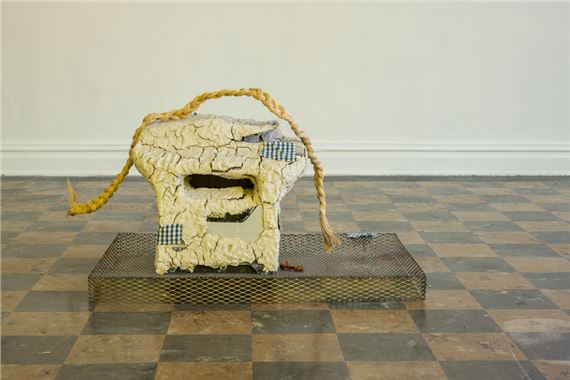ONLINE: Like A Museum Filled With Things And Bones
In the last scene of the 2018 Swedish sci-fi film Aniara, unrecognizable detritus floats inside of an aimless space ship nearly six million years after its voyage began. The film, which is based on Harry MartinsonвҖҷs book-length science fiction poem from the mid-1950s, attempts to touch the deep psychological melancholy of a passenger space shuttle doomed to drift directionless through space for all of eternity. Thrown off its course without fuel to redirect itself in the very beginning of the story, the majority of the film details the slow collapse of this micro-society as supplies, populations, and hopes dwindle. This event is felt viscerally through this final scene where the entropy of the physical matter that once supported life breaks into fine particulates.
This exhibition explores the ways that thingsвҖ”materials, ideas, language, timeвҖ”have come apart from themselves. The works included embody abstractions through separation, distillation, and reconfiguration. In most cases, the works have grown out of recognizable, mundane objects, but through processes of improvisation and extraction from their use-function, they have become category-avoidant and strange. These objects are not discarded or disused, rather they catalog the interstices of breakdowns where meanings collapse or reconfigure through the slow drift of functions and values.
As science fiction narratives offer mirrors-at-a-distance to their concurrent conditions, Aniara reflects the psychological and material impacts of nuclear terror from the time it was first written, and the rampant social, political, and environmental collapse of the present. Similarly, the artworks within this exhibition outline the broader stakes of our current moment, wherein meaning cannot be understood as a given. Things break down into fragments, are re-possessed into new orders, present as alternative schematics, offer new visual languages, and disintegrate the infrastructure of capitalist production. The title is taken from the very last chapter of MartinsonвҖҷs poem, detailing the descent of the shipвҖҷs microcosm into a sarcophagus, вҖңlike a museum filled with things and bones.вҖқ One is left to wonder if this museum represents life, supports it, or if its future was ever alive to begin with.

In the last scene of the 2018 Swedish sci-fi film Aniara, unrecognizable detritus floats inside of an aimless space ship nearly six million years after its voyage began. The film, which is based on Harry MartinsonвҖҷs book-length science fiction poem from the mid-1950s, attempts to touch the deep psychological melancholy of a passenger space shuttle doomed to drift directionless through space for all of eternity. Thrown off its course without fuel to redirect itself in the very beginning of the story, the majority of the film details the slow collapse of this micro-society as supplies, populations, and hopes dwindle. This event is felt viscerally through this final scene where the entropy of the physical matter that once supported life breaks into fine particulates.
This exhibition explores the ways that thingsвҖ”materials, ideas, language, timeвҖ”have come apart from themselves. The works included embody abstractions through separation, distillation, and reconfiguration. In most cases, the works have grown out of recognizable, mundane objects, but through processes of improvisation and extraction from their use-function, they have become category-avoidant and strange. These objects are not discarded or disused, rather they catalog the interstices of breakdowns where meanings collapse or reconfigure through the slow drift of functions and values.
As science fiction narratives offer mirrors-at-a-distance to their concurrent conditions, Aniara reflects the psychological and material impacts of nuclear terror from the time it was first written, and the rampant social, political, and environmental collapse of the present. Similarly, the artworks within this exhibition outline the broader stakes of our current moment, wherein meaning cannot be understood as a given. Things break down into fragments, are re-possessed into new orders, present as alternative schematics, offer new visual languages, and disintegrate the infrastructure of capitalist production. The title is taken from the very last chapter of MartinsonвҖҷs poem, detailing the descent of the shipвҖҷs microcosm into a sarcophagus, вҖңlike a museum filled with things and bones.вҖқ One is left to wonder if this museum represents life, supports it, or if its future was ever alive to begin with.
Contact details










